A lenticular reversal color film system developed by Agfa for the 16mm format in the early 1930s. It was aimed at the amateur market and intended to compete against Kodak’s Kodacolor lenticular film.
Film Explorer

A 16mm fragment of Agfacolor Schmalfilm, from the collection of Erhard Finger, author of the book In Farbe: Die Agfa-ORWO-Farbfotografie (2014). The vertical rows of lenticules are visible; the colors in this B/W reversal copy would have been revealed in projection.
Courtesy of Erhard Finger. Reproduction by Lutz Garmsen.
Identification
9.65mm x 7.26mm (0.380 in x 0.286 in).
Safety, probably cellulose diacetate; 110µm (0.004 in) thick.
Standard 16mm frame rates.
1
Additive: red, green and blue (RGB). Color separations were combined in one single B/W image via an embossed lenticular structure on the film’s base and a three-band RGB filter affixed to the lens of the camera and projector.
None
10.05mm x 7.42mm (0.396 in x 0.292 in).
Reversal, panchromatic B/W by Agfa.
AGFA (possibly further lettering).
History
[This summary of the history of the development of Agfacolor lenticular film is based on a detailed account in In Farbe: Die Agfa-ORWO-Farbfotografie (Finger, 2014), and the sources referenced therein at Bundesarchiv, Koblenz, Germany and the archive of the Industrie- und Filmmuseum Wolfen, Bitterfeld-Wolfen, Germany.]
The company that would become globally known as a producer of photographic products, Agfa, started out in 1867 as Actien Gesellschaft für Anilin-Fabrikation, Berlin – a German chemical company specializing in the production of aniline dyes and stains. Only when they commenced production of photographic products at the end of the nineteenth century, was the name abbreviated to AGFA.
Agfa first produced photographic materials for color photography in 1916, based on Lumière’s Autochrome process, which used red, green and blue starch grains to capture color information on B/W film. This color system, which gave satisfactory results for still photography, did not work well for moving images [see Cinécolor]. The random distribution of colored grains produced a disturbing “color noise” when applied to motion picture film (Alt, 2011: p. 39).
In 1925, Kodak bought the rights to produce and sell a 16mm lenticular film from the French Société du Films en Coleurs Keller-Dorian, which exploited the Patents of Rudolph Berthon and Albert Keller-Dorian. The resulting product was branded Kodacolor and was brought to market in 1928.
Also in 1925, a Dr. Kühne, an employee of the dye manufacturer Farbenfabriken vorm. Friedr. Bayer & Co., had witnessed a presentation of Rudolph Berton's lenticular film in Paris and had written to the management at Agfa suggesting that they invite the Société du Films en Coleurs Keller-Dorian to Germany for a presentation of their technology.
In earlier years, Agfa had not pursued lenticular technology to produce a color film as it was considered practically impossible to achieve good-quality results, at scale. In spite of this, Mr. Verola, the director of the Société du Films en Coleurs Keller-Dorian, and his team, were invited to Berlin – subsequently, a sample of film material from Agfa's plant in Wolfen was sent to Paris, to be embossed with lenticules.
Following these events, lenticular color research was initiated under the lead of Prof. John Eggert, head of the scientific department at Agfa. To succeed in bringing a viable product to the market, Agfa had to overcome two major hurdles: first, the technical implementation – ideally surpassing competitors in terms of image resolution and brightness; second, the acquisition of necessary patents, knowing that Kodak had already acquired them for the US and European territories.
Contractual negotiations were initiated between Agfa and the Keller-Dorian company but came to nothing. The legal situation appeared chaotic and Agfa came to the conclusion that existing patents could be circumvented if the company developed its own way to produce lenticular structures in the film base.
Agfa patented its own embossing technology in 1928, with initial projection tests conducted the same year. In the same manner as Kodacolor, Agfa applied the lenticules vertically across the film. Part of Agfa's plan was to develop a system with finer lenticules than Kodacolor, but which was nonetheless compatible for use with Kodak cameras and projectors. Agfa named its new technology Agfacolor (a name later reused for multiple other products from the company).
In 1929, the Agfa Camerawerk Munich delivered German-manufactured optical components to Berlin, for testing. The significant loss of light inherent with lenticular projection was a known issue, so Agfa also developed a special projection screen,with increased reflectivity, which was branded Pelloro Silber, once it was introduced to the market.
Even though Agfacolor Schmalfilm was intended to be a reversal film for the amateur filmmaking market, research work was carried out on a special optical copying process which would make it possible to produce multiple copies of lenticular films. In addition, a photographic slide film was in development.
Agfa was aiming for a lenticular width of 28 µm (0.028mm), significantly smaller than the 43µm (0.043mm) lenticules of Kodacolor. This would distinguish Agfa’s product in terms of image quality and, at the same time, help avoid the issue of patent infringement. However, this made it more complex maintaining compatibility with Kodak products.
The production of a 28 µm lenticular structure proved to be technically complex. It took the specialist wire manufacturer Drahtwerk Rösslau until 1932 to deliver a 28 µm-gauge wire, uniform enough for the embossing process. Further, the thickness of the film base needed to be reduced to 110 µm (0.11mm) to adjust for the shorter focal length of the smaller lenticules. At the same time, the resolving power of the panchromatic film emulsion reached its limits at this tiny scale. While these challenges were overcome, it was decided to initially limit the process to 16mm motion picture film and delay the development of slide film.
Agfacolor Schmalfilm was introduced to the market in mid-1932 (Anon., 1932). Considering how few reels of Agfacolor Schmalfilm have survived to the present, it can be assumed that very little stock was sold and shot at the time.
In January 1930, a Swiss consortium had been granted the rights to exploit the Keller-Dorian process in Germany, Switzerland, Austria, Czechoslovakia, Poland, Denmark, Holland, Sweden and Norway. Through this consortium, called Opticolor Gesellschaft Glarus, the German Opticolor consortium, lead by Siemens & Halske, came into possession of the licenses. Opticolor was a lenticular film process developed in parallel to Agfacolor Schmalfilm. They pursued the goal of producing a color film production chain for professional application, including the possibility of making lenticular film copies and were thus not in direct competition with Agfacolor Schmalfilm.
In May 1935, Agfa began research work in Wolfen with the aim of developing a lenticular cinema film similar to the Opticolor process. By 1938, when it became clear that the level of illumination required for full-sized cinema projection could not be achieved, this work was discontinued. Meanwhile, the development of Agfa’s lenticular bipack process Pantachrom had progressed to such an extent that it was regarded as having a good chance of solving the problem of color cinematography in Germany.
With the introduction of Agfa’s revolutionary chromogenic Agfacolor Neu 16mm reversal film, beginning in 1937, the production of the lenticular Agfacolor Schmalfilm was halted – in early 1938, development work of Agfa’s “Berliner Umkehranstalt” laboratory for reversal film was also stopped (Alt, 2011).

Right: 7.3 cm Hektor f/1.9 lens with Agfacolor color filters intended for photographing and projecting with 35mm slide film. Left: Agfacolor filters for the Zeiss-Ikon Tessar and Sonnar range of lenses, 1930s. The Zeiss “Contax” mount allowed for the easy addition of the filters to the front of camera and projector lenses.
(left) Leitz Photographica auction house, Vienna, Austria (www.leitz-auction.com/de/Hektor-1.9-7.3cm-w.-Agfacolor-Filters/AI-100-Jahre-30248); (right) www.zeissikonveb.de: a technical history of the German photo industry, “From Ernostar to Sonnar Ludwig Bertele – master of coma correction” (www.zeissikonveb.de/start/objektive/normalobjektive/sonnar.html).
Selected Filmography
A small fragment, probably from this film, remains in the collection of Erhard Finger, author of the book In Farbe: Die Agfa-ORWO-Farbfotografie (2014).
A small fragment, probably from this film, remains in the collection of Erhard Finger, author of the book In Farbe: Die Agfa-ORWO-Farbfotografie (2014).
The director of the Berlin Zoo, and notorious Nazi, Dr. Lutz Heck shot Agfacolor lenticular films in 1936 during an expedition to Canada to obtain bison and moose specimens for the zoo.
The director of the Berlin Zoo, and notorious Nazi, Dr. Lutz Heck shot Agfacolor lenticular films in 1936 during an expedition to Canada to obtain bison and moose specimens for the zoo.
Agfacolor lenticular films were shot during an expedition to India by Hartlmaier, in 1935/6. Hartlmaier’s expedition involved travelling some 17,500km (11,000 miles) across India and Sri Lanka in three German-made DKW cars. It was less an expedition to little-visited regions of South Asia, than a Nazi-backed propaganda/marketing exercise, to show off German technology and manufacturing expertise.
Agfacolor lenticular films were shot during an expedition to India by Hartlmaier, in 1935/6. Hartlmaier’s expedition involved travelling some 17,500km (11,000 miles) across India and Sri Lanka in three German-made DKW cars. It was less an expedition to little-visited regions of South Asia, than a Nazi-backed propaganda/marketing exercise, to show off German technology and manufacturing expertise.
Technology
Agfacolor lenticular film was a reversal lenticular color film system based on the same principles as Kodacolor lenticular film. Agfa tried to set itself apart by using smaller lenticules to achieve better image resolution.
A specially designed silver screen with a high reflectivity was developed, to improve the image brightness.
Lenticular filmstock
The lenticular film stock carried vertical lenticules with a width of 28 µm (0.001 in) and a focal length of 0.10mm (0.004 in), resulting in 366 lines of horizontal image resolution for the 10.26mm-wide image width with standard 16mm film. The thickness of the film base was 0.11mm. Earlier test materials carried lenticules of a width equal to Kodacolor lenticular film (43 µm [0.0017 in]) with a focal length of 0.14mm (0.06 in) and a greater base thickness (Weil, 1933). It seems that Kodacolor samples may have been acquired by Agfa from Kodak, for testing.
To distinguish its production method from that patented by the Société du Films en Couleurs Keller-Dorian, Agfa did not emboss the film base directly. Instead, a matrix was embossed, on to which the film base was then cast – resulting in an lenticulated surface.
Color reproduction
In a memo of February 27, 1934, Gerd Heymer reported that, during a screening of the Agfacolor film Schwäbischer Heimattag Stuttgart Pfingsten (1933), he noticed: “even the deep and bright red of the swastika flags or the helmet bushes” reproduced as too brown. In tests on the spectral sensitization of Agfacolor lenticular film, in comparison to Kodacolor, Heymer came to the conclusion that with Agfacolor “a deep red, which cuts off shortly before 600nm and which roughly corresponds to the red of the flags, [...] is reproduced as brown”. He stated that, regarding color accuracy, Agfacolor performed somewhat worse than Kodacolor film. (IFM, 1934)
Equipment
Agfacolor Schmalfilm was compatible with the Agfa Movex 12 and the Agfa Movex 30 16mm cameras at the following prices: 12m cassette for the Movex 12, 14.30 Reichsmark; 15m cassette for the Movex 30 camera, 19.80 Reichsmark; 30m cassette for the Movex 30 camera, 35.10 Reichsmark (Anon., 1932).
Agfacolor lenticular filter stacks for projection were 14.5mm (0.57 in) wide and were compatible with the Agfa Movector AL and ALL 16mm projectors. (Anon., 1932)
Instead of using an internal iris aperture to regulate the amount of light exposing the film in a regular film camera, slit diaphragms were used to reduce the light intensity. This avoided color distortion. The Kodacolor lenticular system offered neutral-density filters for the same purpose. (Anon. 1932)
At present, none of this custom hardware for Agfacolor lenticular 16mm film, or images thereof, have been found.
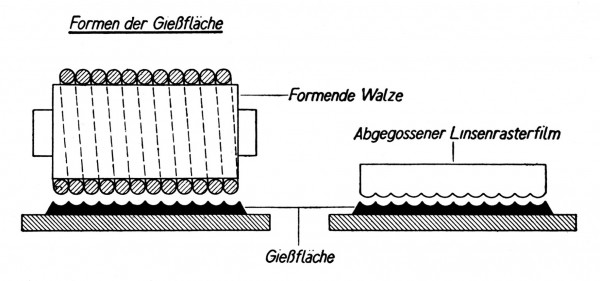
Production of lenticular film by using an embossed matrix for casting the base layer.
Heymer, Gerd (1933). “Auflösungsvermögen und Farbwiedergabe in der Farbrasterphotographie”. Veröffentlichungen des wissenschaftlichen Zentral-Laboratoriums der photographischen Abteilung Agfa, 3: p. 49.
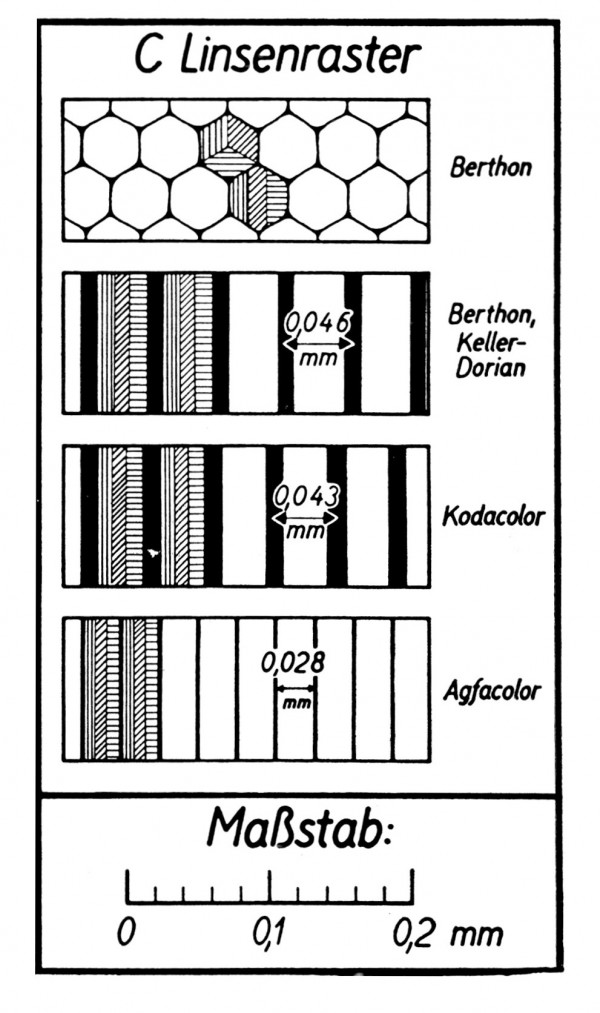
A comparison of the dimensions of various lenticular film technologies.
Heymer, Gerd (1933). “Auflösungsvermögen und Farbwiedergabe in der Farbrasterphotographie”. Veröffentlichungen des wissenschaftlichen Zentral-Laboratoriums der photographischen Abteilung Agfa, 3: p. 189.
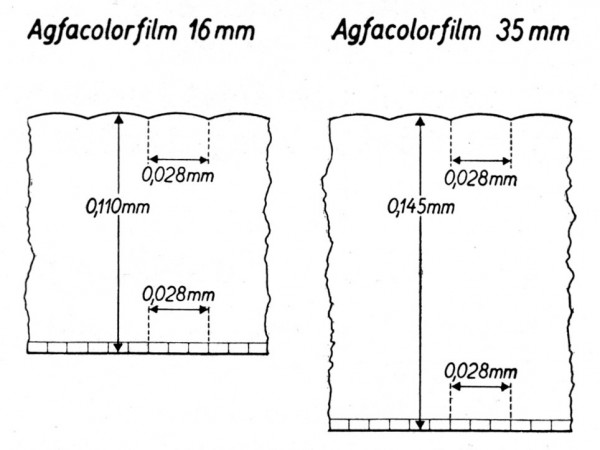
Comparison of the dimensions of 16mm Agfacolor Schmalfilm and Agfacolor lenticular film for 35mm slide photography. In the drawing the focal length of the lenticules of two film stocks looks the same, but it had to be different to accommodate the difference in the depth of the film base.
Heymer, Gerd (1935). “Wesen und Anwendungen des Linsenrasters”. Veröffentlichungen des wissenschaftlichen Zentral-Laboratoriums der photographischen Abteilung Agfa, 4: p. 154.
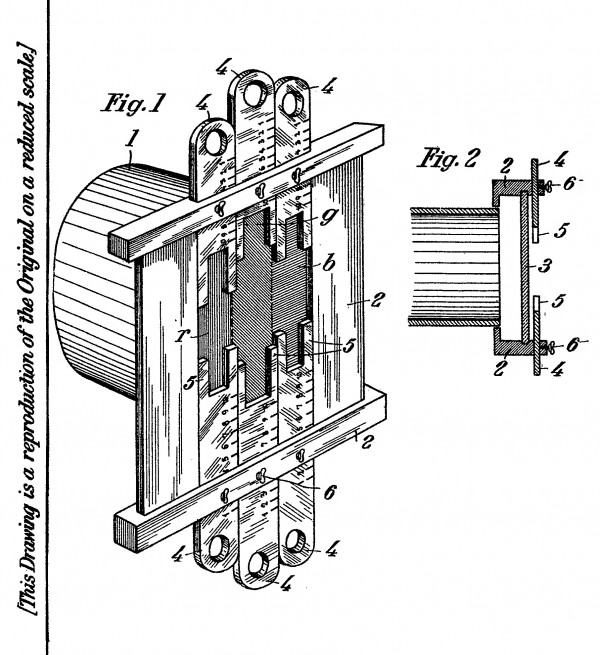
Slit diaphragms, as shown in a Agfacolor patent granted to I.G. Farbenindustrie AG in 1932.
European Patent 366,175.

Digital color reproduction of a frame of a 16mm Agfacolor Schmalfilm fragment from the collection of Erhard Finger. This reproduction was made by Lutz Garmsen of Scan2Screen Switzerland GmbH, using the slit-scan technique. This fragment was probably shot by Dr. Gerd Heymer at the Olympic Games in Berlin 1936.
Scan2Screen Switzerland GmbH, Zürich, Switzerland.
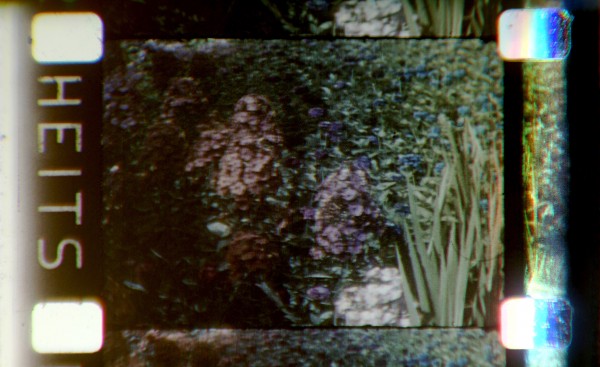
Digital color reproduction of a frame of a 16mm Agfacolor Schmalfilm fragment from the collection of Erhard Finger. The reproduction was made by Lutz Garmsen of Scan2Screen Switzerland GmbH, using the slit scan technique.
References
Alt, Dirk (2011).“Der Farbfilm marschiert!” Frühe Farbfilmverfahren und NS-Propaganda 1933–1945. München: Belleville: pp. 52–3 & 389.
Anon. (1932): “Agfa-Color”. Die Kinotechnik, 14:12 (Jun.): p. 232.
Anon. (1936a). “Unterredung mit der Indien-Expedition Hartlmaier. Dschungeljagden im Farbenfilm”. Völkischer Beobachter, 196 (July 14): p. 8.
Anon. (1936b). “Über die Prärie! Dr. Lutz Heck filmt in Kanada Tiere auf freier Wildbahn”. Völkischer Beobachter, 265 (Sept. 21): p. 6.
Finger, Ehrhard (2014). In Farbe: Die Agfa-ORWO-Farbfotografie. Hildesheim, Germany: Fruehwerk.
Heymer, Gerd (1933). “Auflösungsvermögen und Farbwiedergabe in der Farbrasterphotographie”. Veröffentlichungen des wissenschaftlichen Zentral-Laboratoriums der photographischen Abteilung Agfa, 3: pp. 188–207.
Heymer, Gerd (1935). “Wesen und Anwendungen des Linsenrasters”. Veröffentlichungen des wissenschaftlichen Zentral-Laboratoriums der photographischen Abteilung Agfa, 4: pp. 151–76.
Weil, F. (1933). “The Optical-Photographic Principles of the Agfacolor Process”. Journal of the SMPE, 20:4 (Apri): pp. 301–8.
Patents
I.G. Farbenindustrie AG; Dr. Eggert, John; Dr. Heymer, Gerd. Verfahren zur Herstellung von Filmen mit linearen lichtbrechenden Elementen. Deutsches Reich Patentschrift 558,365, issued Oct. 24, 1928. https://filmcolors.org/wp-content/uploads/2013/05/Patent_AgfaLenticular_EggertHeymer_DE000000558365A.pdf
I.G. Farbenindustrie AG. A Method of Projecting Lenticular Films. European Patent 367,414, filed Nov. 12, 1930, and issued Feb. 12, 1932. https://filmcolors.org/wp-content/uploads/2013/10/IGFarbenindustrie_Agfacolorlenticular_GB000000367414A.pdf
I.G. Farbenindustrie AG. A Method of and Device for Obtuarating Photographic Objectives having a Multicolor Filter. European Patent 366,175, filed Nov. 17, 1930, and issued Feb. 4, 1932. https://filmcolors.org/wp-content/uploads/2013/10/IGFarbenindustrie_Agfacolorlenticular_GB000000366175A.pdf
I.G. Farbenindustrie AG. Improvements in or relating to the Production of Lenticular Elements on film. European Patent 376,225, filed Jan. 20, 1932, and issued June 23, 1932. https://filmcolors.org/wp-content/uploads/2013/10/IGFarbenindustrie_Agfacolorlenticular_GB000000375225A.pdf
I.G. Farbenindustrie AG. Improvements in Projecting Multi-color Pictures. European Patent 383,795, filed Jan. 18, 1932, and issued Nov. 24, 1932. https://filmcolors.org/wp-content/uploads/2013/10/IGFarbenindustrie_Agfacolorlenticular_GB000000383795A.pdf
I.G. Farbenindustrie AG. Improvements relating to the Manufacture of Films for Color Photography. European Patent 375,229, filed Jan. 27, 1932, and issued June 23, 1932. https://filmcolors.org/wp-content/uploads/2013/10/IGFarbenindustrie_Agfacolorlenticular_GB000000375229A.pdf
I.G. Farbenindustrie AG. Improved Manufacture of Multi-color Light Filters. European Patent 401,963, filed April 7, 1933, and issued Nov. 23, 1933. https://filmcolors.org/wp-content/uploads/2013/10/IGFarbenindustrie_Agfacolorlenticular_GB000000401963A.pdf
Followed by
Compare
Related entries
Author
Dr. David Pfluger has a PhD in physical chemistry, University of Basel, Switzerland. After his graduation in 2002, he worked for six years in cinema post-production before entering the field of time-based media preservation. He has been an active member of the film and video competence networks of Memoriav, Switzerland since 2005, and has been involved in several research projects in the field of media conservation since 2010. He is part of the technical team who developed the Scan2Screen multispectral film scanner specifically aimed at overcoming some of the challenges faced in the preservation of film colors. Since 2023, he has been in charge of the film collection at Lichtspiel, Kinemathek Bern, Switzerland.
Erhard Finger; Timeline of Historical Filmcolors (www.filmcolors.org).
Pfluger, David (2025). “Agfacolor Schmalfilm”. In James Layton (ed.), Film Atlas. www.filmatlas.com. Brussels: International Federation of Film Archives / Rochester, NY: George Eastman Museum.


